February 10, 2008
CCCX MTB #1, Fort Ord, CA
3rd, Janet Lafleur, Beginning Women
4th, Cindy Shambaugh, Beginning Women
5th, Michelle Perez, Beginning Women
3rd, Katy Kintz, Junior Women 18 & Under
2nd, Tracie Nelson, Sport Women 19-34
1st, Sue Lovecchio, Sport Women 45+
3rd, Daphne Hodgson, Sport Women 45+
3rd, Beth Welliver, Pro/Expert Women
Tips for Holding Position in the Pack
February 7, 2008
From Michael ~
No doubt about it – holding position in a pack is definitely one of the more advanced skills we can learn in bike racing. It’s hard and really takes a lot of concentration and … sometimes … effort.
But, the more you practice it and incorporate it into your everyday riding – the less energy you’ll end up using and the more it will become instinctive and 2nd nature.
– – –
Where to be in the pack?
Personally, i live by the mantra – near the front, but not at the front.
Meaning ~ riding in the top 1/3 of the pack to get the benefits of the draft and to be able to cover attacks that shoot out the pack or make my own attacks. As we have all found out … riding in the back 1/3 of the pack in bike races is MUCH harder physically than riding in the top 1/3. When in the back of the pack, we have to accelerate harder out of corners and there is little ‘wiggle-room’ to slide back if there is a hard section of riding (climbing or crosswinds, for example). Once you’re out of the protection of the pack … it’s dang hard to get back and often it can mean a long solo effort to the finish.
So, my goal is to always try and ride in the top 3rd of whatever sized pack i’m in. If i fade back a bit, i don’t stress about it … but i also make the conscious decision that i don’t want to be there and MUST move up.
How to move up in the pack?
The vast majority of the time, moving up in the pack is an exercise in using as little energy as possible to get the job done. And, there are two main ways to do it:

- Speed differential ~ here are a few scenarios when this can occur:
– when you see a slowing in the pack and there is an opportunity for you to NOT hit your brakes, and instead, safely slide up and around the growing mushroom of the pack, making your way past rider after rider with your continued speed as they all slow down (for whatever reason). The keys to this are to make your initial lateral movement out of the pack predictable and relatively slow so that if there is a rider behind you desiring to do the same thing, they have opportunity to recognize what you’re doing and adapt their action. Also you will want to be relaxed and make sure you are watching the riders as you pass by them, trying to predict if any of them will scoot out in front of you. And lastly, you will want to know EXACTLY what the terrain is ahead of you. If there is a sharp turn coming up, that may not be the best time to use this tactic to move up in the pack … because you might just lose all those places just past in the pack as you brake awkardly to set up for the turn.
– at the top of a hill: often, the few meters right after a small climb offer a good place to move up in the pack. Riders will often lay off the gas a bit and the speed will drop as they recover and look around at the damage done after the climb. 4 or 5 seconds of continuing the same effort you had up the climb as you crest over it will often push you past many riders in the pack without a huge amount of energy used. There isn’t much downside to this tactic as it is often save AND it can sometimes be a wee bit intimidating to your competitors to see you spinning smoothly and quietly past them after a hard little kicker.
– as a descent levels out: many times the group will slow down at the end of a descent because all of a sudden someone has to pedal hard to keep the speed up (instead of just coasting along). This is often the easiest way to move up in position because you can pedal at a moderate amount of effort to maintain a much faster speed than those continuing to coast. However, this calls for an increased awareness of what riders are doing ahead of you. You’ll want to concentrate hard on predicting what riders will do ahead … focusing on if riders will be moving into your line of trajectory past the pack.
- Riding the wheel ~
often this is the most efficient way of moving ahead in the pack while the speeds are still high. it can also be the trickiest.
When you’re in the pack and you see someone riding in the wind, passing and moving up in position … heck, why not hop on their wheel and take the ride? The trick is, as you see them moving past you, slightly … ever so slightly start to move an inch or two towards them (they are already moving past you at this point). Then, as you’ve started that few micro-seconds of movement towards their bike, just glance back in your peripheral vision to see if there is a body right behind them.
The key is … to glance and use your peripheral. I’ve found that riders turn their heads too much and ignore the significant range of vision given to us naturally by our eyes. Right now, at your computer, just move your eyes completely to the right. See how far you can see to behind you? Now, place your hands on your keyboard and turn your head and look to the right and behind you. Go ahead and do it.
Did you feel your shoulders turn?
Yes, that’s the key. Your shoulders turned, didn’t they … ever so slightly. And – when you’re on the bike, that’s exactly what happens … your shoulders turn and … so does your bike! So, instead – try looking with your eyes and using your peripheral vision a bit more to see who is around you and slightly behind.
Back to riding the wheel ~ if you begin to move slowly towards taking the draft of the rider passing you, the rider right behind them might just let you in naturally. Don’t hesitate, if you see daylight – go ahead and slowly take the wheel, all the while increasing your speed to get in the draft of the rider passing. If the rider behind that wheel doesn’t let you in, KEEP PEDALING, and then try the same tactic behind that rider. You dig?
Again, it’s a tricky business … however, this is a skill that, if practiced, becomes the bread and butter of keeping position in the pack. You’re always looking for wheels to slide onto to move you forward.
Pre-empt the swarm!!!
And this is the most valuable trick of the trade, i reckon, in holding position in the pack.
You’ve done it, you gotten to the front of the pack and happily see yourself riding 10th or 12th wheel with no problems. And then … dang it! … there’s a slow down in the pack and swooosh, 20 riders just swarmed past you and now you’re in the butt-end of the pack.
all in a few seconds.
What to do?
Here is the thing to burn into your consciousness … swarms are predictable. Here are the things you’ll see and feel:
- Seeing the slowing at the front: anytime there is slowing at the front, it must be an AUTOMATIC response from you to look for ways to move up. You can use any of the above tips … sliding around the pack, riding a wheel … whatever. just keep moving forward (safely).
Slowing at the front is very visible. Anytime the string of riders becomes more dense, billows out, mushrooms (whatever) – that is the time you must INSTANTLY look to move up. If it’s not safe to do so, so be it. But, the key is to make it 2nd nature that you are looking for such opportunities. EVERY TIME.
- Feeling the swarm from behind: anytime you feel riders moving up from behind … it should be a warning signal. Honestly, this is most evident in sprint finishes and … really is one of the harder skills to work on.
When you feel riders swarming around the pack, it needs to be an automatic reaction to try and squirm your way into that line of riders, safely and quickly. The key is to pedal. The key is to match the speed of that swarm and move your way slowly into the pathline of their advance.
Maybe the first few riders won’t let you in … but, if you don’t try, none of them will. And to move up in position .. you must try.
Which leads me to my final point – moving up and keeping position in the pack takes EFFORT. The goal is to minimize that amount of effort. And, the more experience and practice you have, the less energy you will have to use to keep position near the front of the pack.
The keys are: recognizing that you must move forward, deciding you will move forward, and committing the energy required to move forward.
In a finish, it doesn’t mean anything if you’ve saved energy and yet you aren’t near the front to use it. Being at the front of the race costs energy. Spend it. Spend it over and over again … because eventually, you’ll learn how to do it efficiently.
February 3, 2008
Mothballs Criterium, CA
5th, Ryan Hostetter, Women 1/2/3
Boulevard Road Race, CA
8th, Thea Rusthoven, Women 35+ 3/4
30th, Raja Lahti, Women 35+ 3/4










